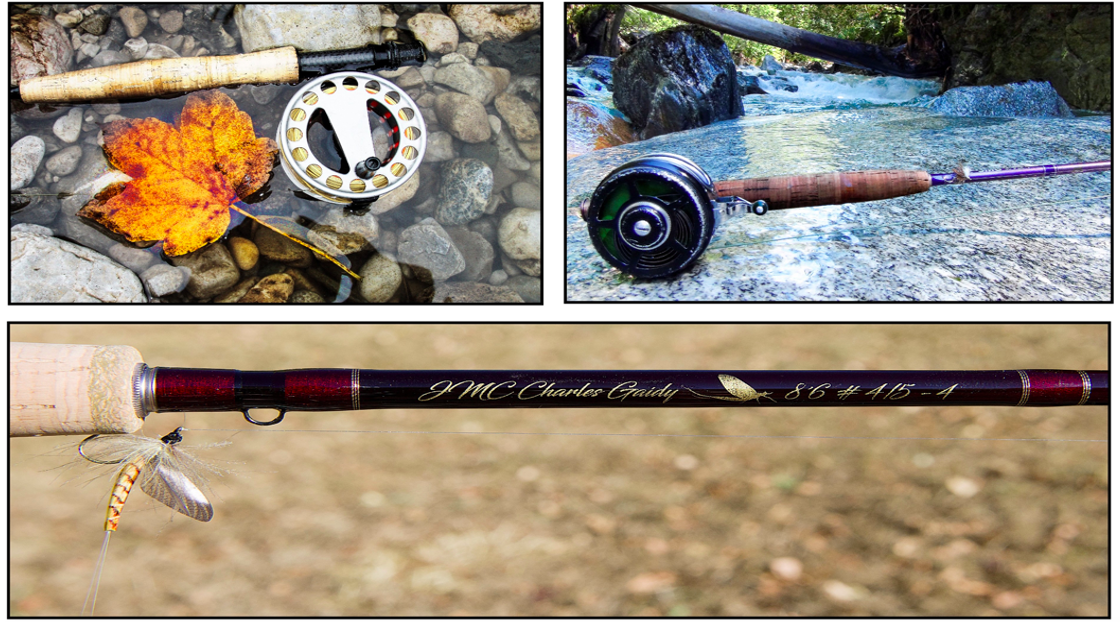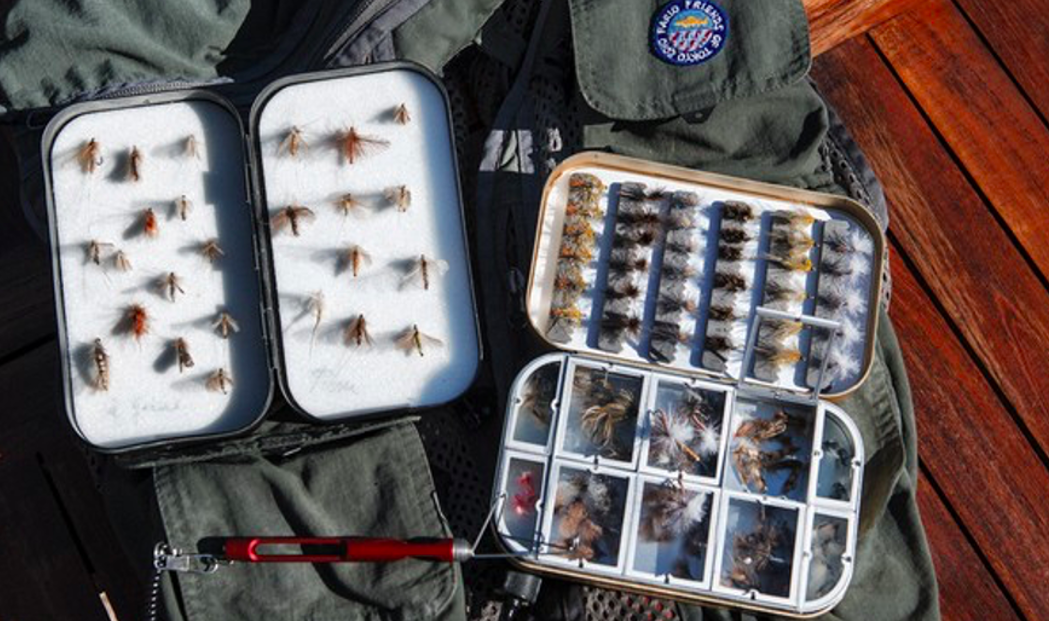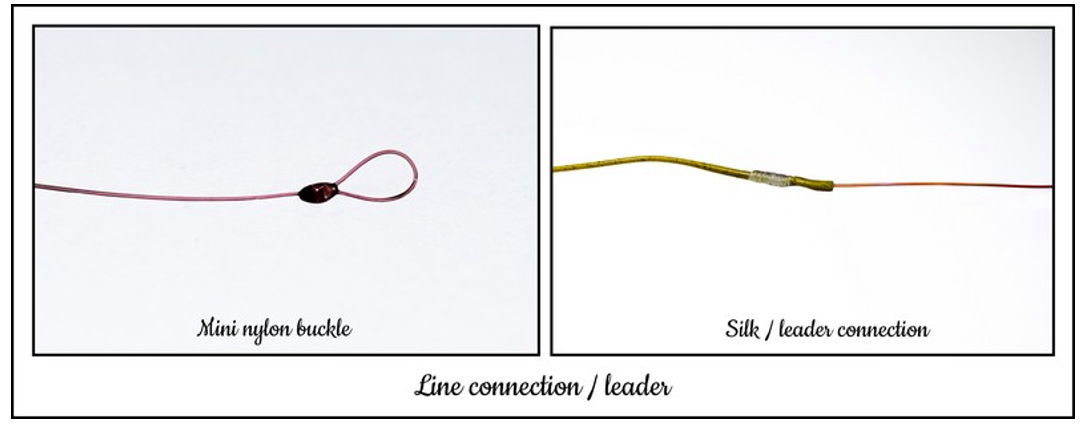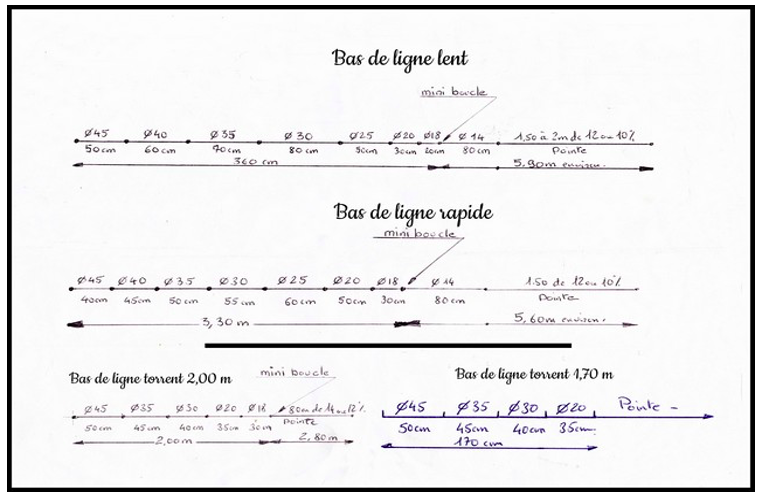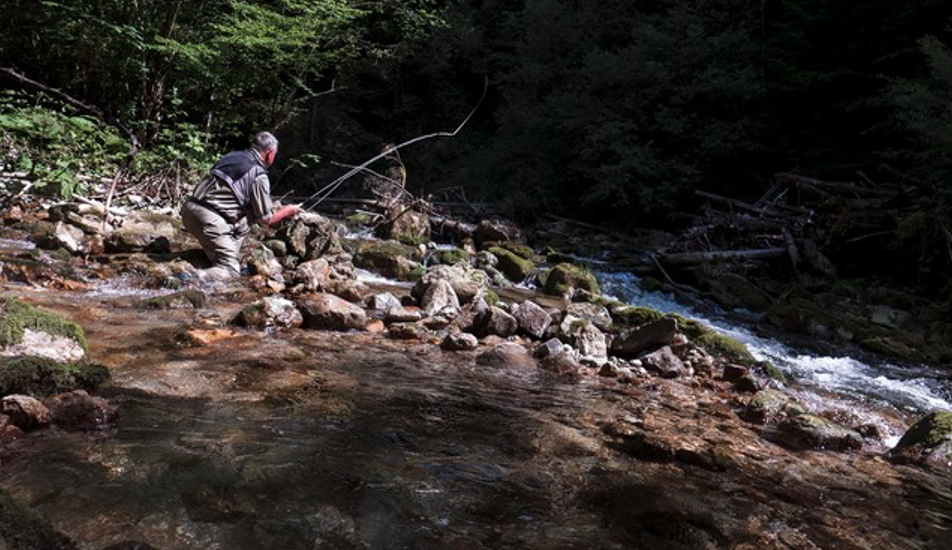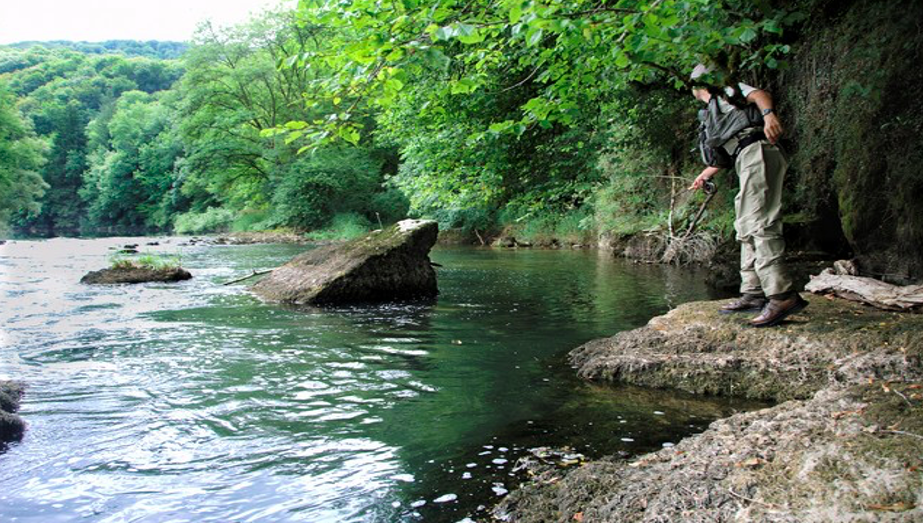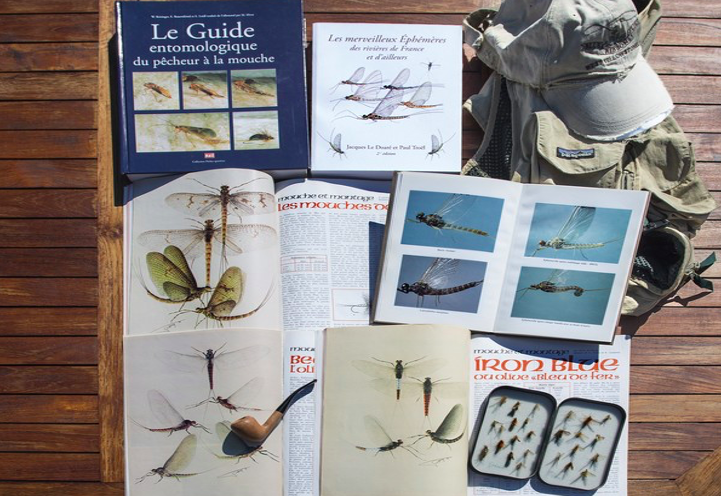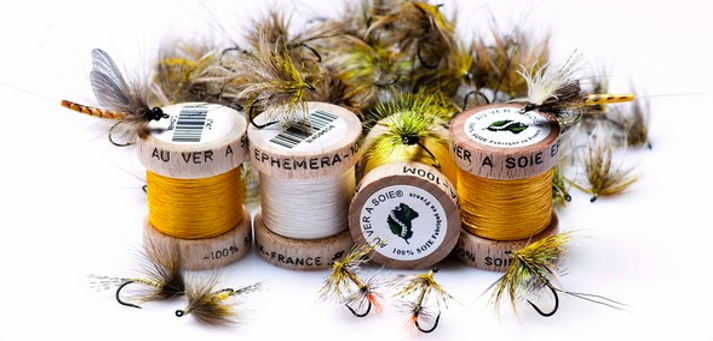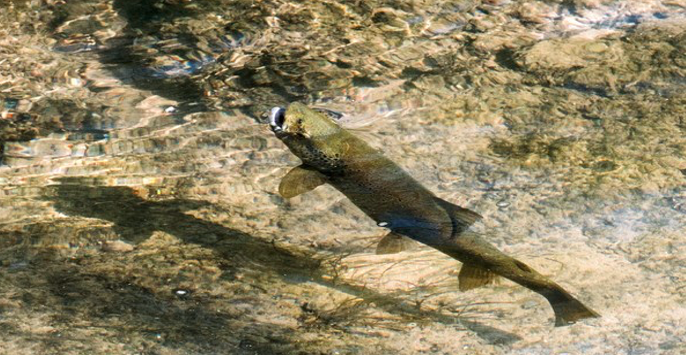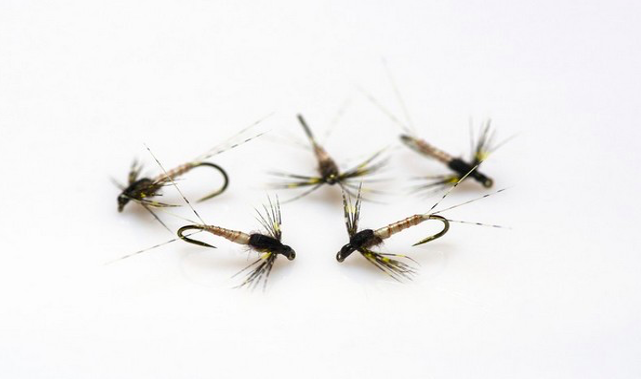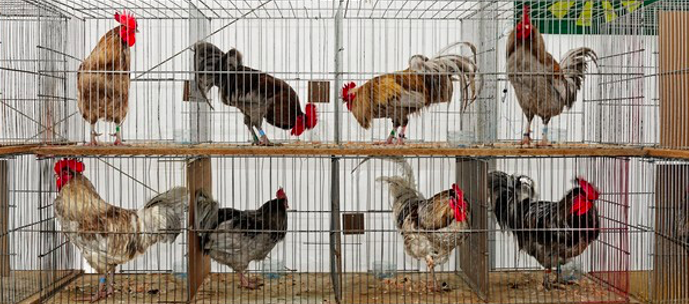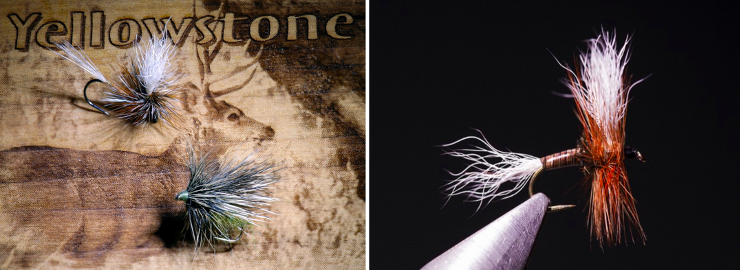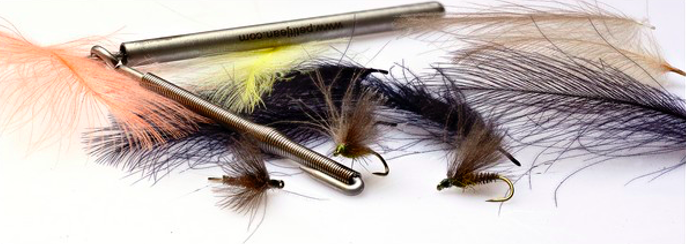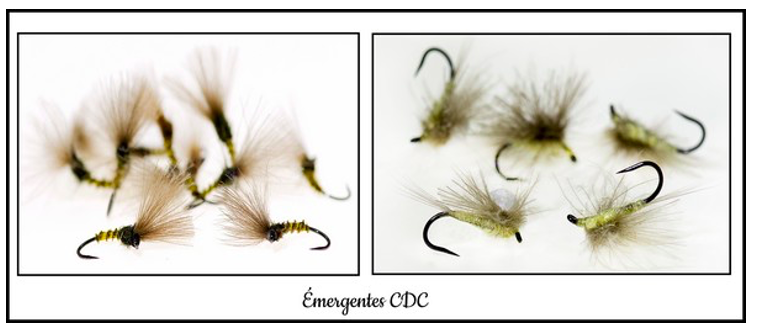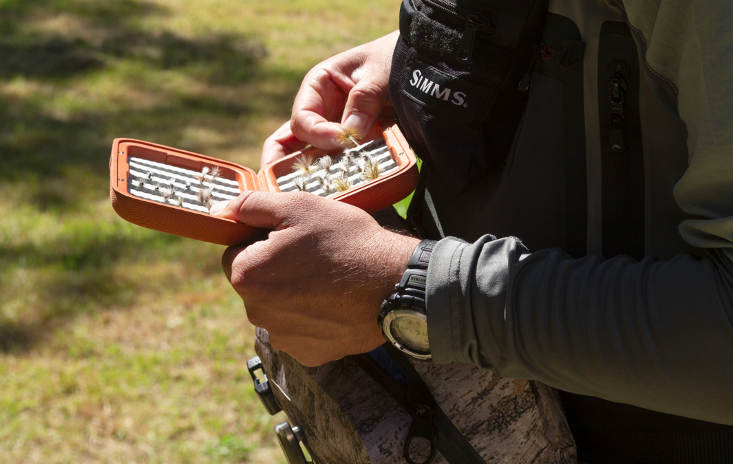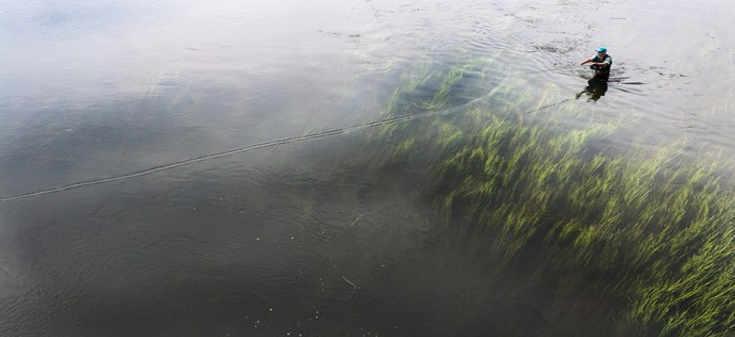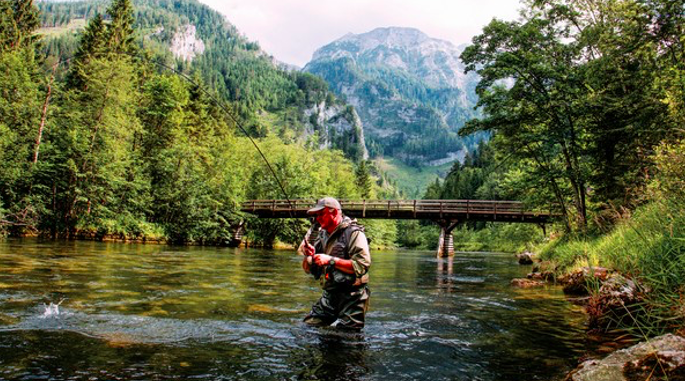
Gérard Piquard.
Traduction vers l'anglais Malik Mazbouri simfly.ch
1. Choice of equipment Rods, reels, fly lines, fly floatants, clothes, glasses and other useful items.
The rivers I fish are mainly slow lowland chalk streams, and mountain rivers in Bavaria, Austria and Slovenia.
I take great pleasure in fishing only with dry flies or at sight with light nymphs. I use 8.6 and 9 foot rods with a fairly strong tip action, this is to avoid false casts and get into action quickly when sight fishing.
The reel is a solid model with a good capacity that I use with 3 removable spools containing each one a floating line type WF of colour olive numbered of # 4, # 5 and # 6, what allows me to change quickly line according to the conditions met during the fishing.
For mountain river I use an automatic reel of the Cordel or Abeille type which are no longer manufactured. They have followed me in my fishing peregrinations since I started 40 years ago, and I appreciate them a lot. My fly boxes are Wheatley type with trays and foam, a disgorger and kitchen paper to dry my flies. I almost never use grease on my flies so as not to make the fly fibres stick together. For the CDC I use Marc Petitjean's CDC float, and for the hackles I use Tiemco's Dry magic. My equipment consists of waders or boots and a Gore-tex rain jacket, a fleece jacket and Capilene underwear from Patagonia, a brand that actively participates in actions to protect our rivers. A cap with a large visor completes my equipment as well as polarized glasses that were made for me by an optician.
2. Leader material, build up, length and knots.
The leader is inserted inside the line, glued and tied to facilitate the passage through the rings. The tip holder is finished with a mini loop, which allows the tip to be changed without reducing the length of the tip holder.
I use leaders that I make from Maxima nylon of various diameters. For dry fly fishing in wading, I use a slow leader with a length of 3.60 m without the tip. This leader with the tip is about 5.90 m long, this long length allows long drifts. I use it on heavily fished rivers with difficult fish that follow the drift of the fly by watching it for a long time.
The formula I use most often is a fast leader that allows you to fish alternatively with dry flies or nymphs at sight. Slightly shorter, it allows for accurate nymphing.
For stream fishing, depending on the configuration of the river, I choose one of the two formulas in
1,70m or 2,00m
3. Approach and stealth
This is the most important element for a successful fishing . You must not rush into action at the sight of a beautiful fish in position. Making the mistake of entering the river without thinking is a sure-fire failure for many anglers. Shadows cast by light on the surface of the river must be avoided at all costs, and this is best avoided by fishing facing the sun. If the approach is made by wading, it is necessary to avoid making noise while walking, the shock between pebbles is echoed and makes the fish flee immediately. It is also necessary to walk very slowly without making waves on the surface, it is by dominating its stress that one arrives there, if the fish in position did not locate you, it will be there still a few minutes more.
As soon as you get within range of the fish you have spotted, you have to avoid making quick and nervous false casts towards it, I always leave a few metres of line behind me, and I only make two or three false casts opposite the fish. Another cause of almost certain refusal, it is necessary never to line the fish with the leader and even worse with the linem itself, the flight of the fish will make you complain against your haste. A good approach and a successful landing is 80% of success.
The most beautiful fish are often found in places that are difficult to access, where sometimes casting is not possible because of vegetation or natural or artificial obstacles, and a water depth that is too deep, so you must fish with the bow and arrow cast. It is not the most academic technique, it does not allow you to send your imitation more than a few meters away, but when everything goes well this way of casting brings beautiful catches.
Although you don't enter in the river, you have to be extra careful to get into position, not to step on branches or roll stones, to move forward by bending and not to move the foliage, which is not always easy when the shoreline is lined with bush thorns or lush vegetation.
4. Reading the water
I was lucky enough to be born into a family where all the men, without exception, were passionate about fishing, family dinners were often lively, and woe betide the cousin who was engaged to a guy who didn't go fishing !
I was very young at that time, we went every weekend to fish for pike, I was in charge of fishing the livebait. I still remember my first catch, it was a gudgeon, from that day on, fishing had definitely become my only occupation. I then perfected my knowledge by buying magazines and books which were quite rare at that time, video did not exist.
The sense of the water is an expression which gathers all the knowledge acquired during a career, and which concerns the observation of the places, the reading of the various spots to fish or to avoid according to the level of the river. The behaviour of the fish is essential, it is necessary to observe whether they are feeding or resting, to determine their diet and at what stage of the hatching the insect will be taken. The understanding and the ability to analyse all the situations experienced at the water's edge, allow you to approach your fishing calmly. It is the result of a life spent satisfying a passion which leads the fly fisherman to survey the waterways of his country, and which sooner or later will make him leave for sometimes very distant stays abroad on rivers which haunt his dreams. It is the compilation of the good days and the bad days that are unconsciously engraved in the brain of an itinerant fisherman.
All these observations go hand in hand with the technical mastery of the practice of fly fishing, passing from the dry fly or the emergent if the fish take on the surface, or in nymph on sight if they are in activity under water. One must always be concentrated, adapting to the circumstances until the gestures become natural and without constraint. It is often the privilege of the "vieille main" to know where to fish in a river, even unknown, and to pass on the knowledge of a career to friends.
5. Casting ability which casts are essential.
You don't just choose the right days to go fishing, the weather conditions are the ones you find when you arrive at the river bank. The fisherman must be able to adapt to the area he has to prospect, to know how to position himself to have the wind as an ally if it is a very windy day. Most of the time it is not necessary to cast for hours in double haul, but it is necessary to master the main basic casts, the overhead cast is the simplest, the curved cast, the backhand cast and the parachute cast. If the angler is skilled in these different casting techniques, he will adapt to the fishing conditions, and make his casts easily in the most natural way. The good control of the landing of the line generates a good drift which ends in a good presentation, and maybe, if Saint Pierre is with us, the catch of a beautiful fish.
6. Entomology, what should we know.
Among fly fishers, there is a different approach depending on the sensitivity of each angler. Some have no interest in the aquatic life on the river at all, they have been fishing for years with tried and tested patterns and they often achieve great fishing. They are usually locals who are close to the river and are avid fishermen. I was lucky enough to know one of these people : Roger Simon. He was a friend of my family, none of his children were fishermen. He was happy for the beginner that I was to share with me the good moments of a fishing day. He made his own rather rustic spider flies, with feathers he took from the farm roosters, he had in one of the pockets of his old faded velvet fishing jacket, a pouch with a few hooks and feathers, and in his tin box of sore throat lozenges a few models in stock. When the need arose, he made one without the aid of a vice. His favourite was a raffia body with a mixed collar of red and straw yellow hackle.
Others are interested in recognising a few mayflies, but in general it is the fishing that motivates them.
The exciting thing about fly fishing is that you can take an interest in the life of the river during the day and then go home you can try to identify it. Entomology is a fascinating science in this respect, for my part, I consider myself as an amateur, but I am lucky enough to have as a friend Michel Hivet, a recognised entomologist whom I thank for his patience in helping me to recognise some mayflies on the banks of the Loue, and Charles Gaidy, a recognised animal painter and author of well-known books on entomology.
I have acquired a few books to make insect life a little less difficult to understand, on their advice, the study of stomach contents has taught me a lot, I like to consult these books at my leisure especially as numerous tying formulae are attached for each family of mayflies, caddisflies or stoneflies. For a fly tyer, this is invaluable.
The current fashion is to go fishing only to catch as many fish as possible, to make photographs or films, to present them on social networks. These fishermen are totally unaware of what makes a fly fisherman, they are missing out on an art that ancient authors were able to transcribe so well in their writings. For my part, I prefer to understand rather than take (comprendre plutôt que prendre).
7. Rise forms Can they tell us something?
When a fish moves to feed on a mayfly on the surface of the water, it breaks the water by sucking in the fly. This more or less sharp and sonorous deformation is accompanied by a circle known as a rise. Dry fly fishing for rise is the essence of fly fishing, as it forces the angler to lay down the surface near the gobage of the active trout, and to drift his artificial fly in the most natural way possible in order to avoid the refusal of the fish. However, the fact of visualizing a nice rise does not mean that the fish is feeding on well-floated flies. It was rising all over the place, and I didn't manage to catch a single fish. How many times have I heard these phrases filled with frustration, the result of a disappointing day of fishing ! I myself, in my early days, when the hatchlings still worthy of the name were at certain times bubbling up the river, was sure to make a good catch. My best imitations, which floated high on the surface, were disdained and did not interest a single fish, when the fishing party was over, I tried to understand the cause of my failure, and I could not find the solution. Much later, with a little more experience, the observation of repeated rising was actually tailings.
The fish takes under the film of the surface the nymph inflated with air which finishes its rise to carry out its moult, tired by its moult it constitutes an easy prey for the predators. This is the most deceptive case, the beautiful swirl is caused by the back of the fish turning over, you have to be careful and fish accordingly, the technique of fishing rise on unweighted surface nymphs of the GEM Skues type is often productive.
The gobages are often different between the catching of a gracile mayfly, which causes a discreet, almost inaudible aspiration, and that of a caddis or a stone fly, where the fish rushes on the insect and seizes it precipitately, the gobage is very noisy and powerful, especially in the coup du soir, which allows us, when the visibility is almost zero, to spot the fish in activity.
Even with the experience of years of practice, an old professional fisherman in the valley taught me a proverb full of common sense, and I admitted that « there are days for the fisherman, and days for the fish », and that's just as well.
8. Fly selection, Size, shape, materials, which flies are essential.
I have been making my own flies since I started fly fishingv. It is very important to have a high quality fly tying material, wether it is hooks, feather hackles or furs. The colours of the retail materials are often too flashy, so I dye most of my furs and quills myself. The quality of the rooster feathers is important, they must be brilliant. I choose them from the best breeding farms.
For mountain river fishing, I use parachute flies or Klinkhammer in size 10/12/14/16.
For lowland river fishing r fishing, I use CDC flies in sizes 14/16/18 and 20. My favourite fly is the
Ornans fly in sizes 16 and 18, yellow and orange body, starling quill body, it is one of the best for grayling and trout fishing.
For fine fishing and difficult fish, shuttlecock in size 16/18/20 with a light yellow condor quill body submerged in the water, only the CDC wing emerges to the surface, and the emerging CDC parachute in size 16 and 18 yellow, orange or red body are my favorite flies.
To fish the water and for the coup du soir, my favourite fly is mounted with deer ear hair (ORC) with a white polypropylene head for good visibility in the dark in sizes 12/14 and 16. I also use a polypropylene bubble and size 14 and 16, the collar is made with a dubbing loop in deer ear hair (https://pouic.gobages.net/loreille-de-chevreuil-quelques-modeles/)
9. Presentation and drifts.
To fish well, it is important to use good material, especially floating line. I often use, and especially when the weather conditions are bad with wind that hinders the casts, a natural line WF 4 or 5. For a weight that corresponds to the number given on a synthetic line, it is finer, heavier and penetrates better during the cast, as it floats higher, the pick up is done discreetly, and the dragging will be less. The presentation of the fly must be perfect, it is imperative to make as few false casts as possible to avoid scaring the fish. I use natural silk from Pêche à soie (https://www.pecheasoie.com/double-fuseau-dt-30m-6mm-c2x23104806)
10. Upstream or downstream?
It all depends on where you are, if a hatch is triggered with regular rise upstream and downstream of the angler, he will fish without moving from his place. If the fishing regulations impose fishing only upstream and forbid downstream, the question does not arise, a fly fisherman must scrupulously respect the regulations where he is fishing, and even more if he is invited on a fishery by another fisherman. Downstream fishing allows natural drifts, the dredging occurs practically at the end of the drift, the fish has all the leisure to follow the artificial fly and to eat its prey if no micro-drag often imperceptible occurs. Upstream fishing requires more technical casts, the curved cast allows the fish not to be covered with the leader, and the parachute cast makes the line fall in a bundle, it will progressively straighten with the action of the current without significant dredging.
11. Fighting fish
It is important not to use too fine tippet to avoid prolonging the duration of the fight, and to increase the chances of the fish surviving if you choose to release it into its natural element, a landing net will also reduce the duration of the fight. Keep the rod at mid-height and not in a vertical position to use the action of the rod and the power of the handle.

